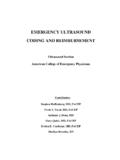Transcription of Emg Ultrasound Imag Crit Comp 0406
1 American College of Emergency Physicians PO Box 619911 Dallas, TX 75261-9911 972-550-0911 800-798-1822 Emergency Ultrasound Imaging Criteria Compendium Approved by ACEP Board of Directors April 2006 This compendium contains the following criteria: Aorta Biliary Echocardiography Pelvic Ultrasound Renal Trauma Ultrasound -Guided Procedures Venous Thrombosis Aorta 1. Introduction The American College of Emergency Physicians (ACEP) has developed these criteria to assist practitioners performing emergency Ultrasound studies (EUS) of the abdomen and retroperitoneum in patients suspected of having an acute abdominal aortic aneurysm (AAA).
2 Ultrasound has been shown to be accurate in identifying both aneurysmal and normal abdominal aortas. In most cases, EUS is used to identify or exclude the presence of infrarenal AAA. In some cases, EUS of the abdominal aorta can also identify the presence of suprarenal AAA or of distal dissection. If thoracic aortic aneurysm or proximal dissection is suspected, these may be detected using transthoracic techniques or may require additional diagnostic modalities. Patients in whom AAA is identified also need to be assessed for free intraperitoneal fluid.
3 EUS evaluation of the aorta occurs in conjunction with other EUS applications and other imaging and laboratory tests. It is a clinically focused examination, which, in conjunction with historical and laboratory information, provides additional data for decision-making. It attempts to answer specific questions about a particular patient s condition. While other tests may provide information that is more detailed than EUS, have greater anatomic specificity, or identifies alternative diagnoses, EUS is non-invasive, is rapidly deployed and does not entail removal of the patient from the resuscitation area.
4 Further, EUS avoids the delays, costs, specialized technical personnel, the administration of contrast agents and the biohazardous ACEP Policy StatementACEP Policy Emergency Ultrasound Imaging Criteria Compendium Statement Page 2 American College of Emergency Physicians PO Box 619911 Dallas, TX 75261-9911 972-550-0911 800-798-1822 potential of radiation.. These advantages make EUS a valuable addition to available diagnostic resources in the care of patients with time-sensitive or emergency conditions such as acute AAA.
5 2. Indications/Limitations a. Primary i. The rapid evaluation of the abdominal aorta from the diaphragmatic hiatus to the aortic bifurcation for evidence of aneurysm. b. Extended i. Abdominal aortic dissection ii. Thoracic aortic dissection iii. Intraperitoneal free fluid in the event that AAA is identified iv. Iliac artery aneurysms c. Contraindications i. There are no absolute contraindications to abdominal aorta EUS. There may be relative contraindications based on specific features of the patient s clinical situation.
6 D. Limitations i. EUS of the aorta is a single component of the overall and ongoing resuscitation. Since it is a focused examination EUS does not identify all abnormalities or diseases of the aorta. EUS, like other tests, does not replace clinical judgment and should be interpreted in the context of the entire clinical picture. If the findings of the EUS are equivocal additional diagnostic testing may be indicated. ii. Examination of the aorta may be technically limited by 1. Obese habitus 2. Bowel gas 3.
7 Abdominal tenderness e. Pitfalls i. When bowel gas or other technical factors prevent a complete systematic real-time scan through all tissue planes, these limitations should be identified and documented. Such limitations may mandate further evaluation by alternative methods, as clinically indicated. ii. A small aneurysm does not preclude rupture. A patient with symptoms consistent with acute AAA and an aortic diameter greater than cm should have this diagnosis (or alternative vascular catastrophes) ruled out.
8 Iii. The absence of free intraperitoneal fluid does not rule out acute AAA as most acute AAAs presenting to the ED do not have free peritoneal fluid. iv. The presence of retroperitoneal hemorrhage cannot be reliably identified by EUS. v. If an AAA is identified, it still may not be the cause of a patient s symptoms. vi. While most aneurysms are fusiform, extending over several centimeters of aorta, saccular aneurysms are confined to a short focal section of the aorta, making them easily overlooked. This may be avoided by methodical, systematic real-time scanning through all tissue planes.
9 Vii. Oblique or angled cuts exaggerate the true aortic diameter. Scanning planes should be obtained that are either exactly aligned with, or at exact right angles to, the main axis of the vessel. viii. With a tortuous or ectatic aorta longitudinal and transverse views should be obtained with respect to the axis of the vessel in order to avoid artifactual exaggeration of the aortic diameter. ix. Large para-aortic nodes may be confused with the aorta and/or AAA. They usually occur anterior to the aorta, but may be posterior, displacing ACEP Policy Emergency Ultrasound Imaging Criteria Compendium Statement Page 3 American College of Emergency Physicians PO Box 619911 Dallas, TX 75261-9911 972-550-0911 800-798-1822 the aorta away from the vertebral body.
10 They can be distinguished by an irregular nodular shape, identifiable in real-time. If color flow Doppler is utilized nodes will not demonstrate luminal flow. 3. Qualifications and Responsibilities in the performance and interpretation of EUS of the aorta EUS of the aorta provides information that is the basis of immediate decisions about further evaluation, management, and therapeutic interventions. Because of its direct bearing on patient care, the rendering of a diagnosis by EUS represents the practice of medicine, and therefore is the responsibility of the supervising physician.


